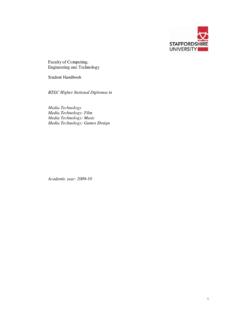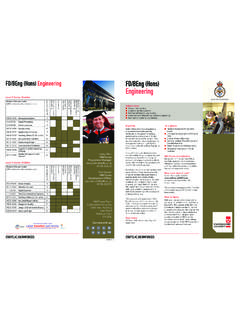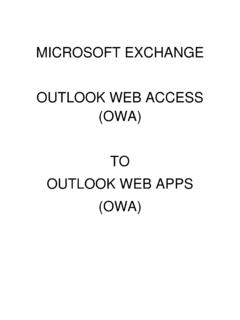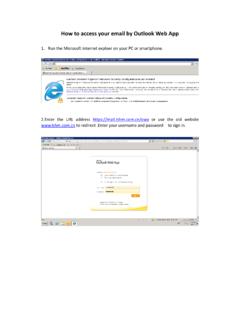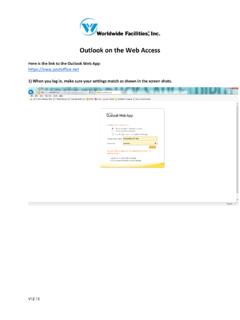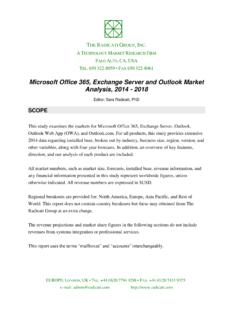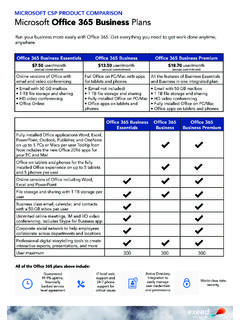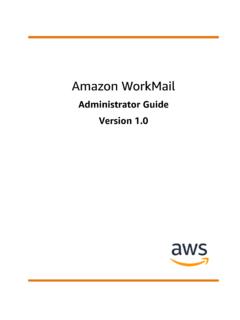Transcription of Microsoft Outlook 2007® Introductory guide for …
1 Platform: Windows PC Ref no: USER180 Date: 8th January 2008 Version: 1 Authors: Julie Adams, Claire Napier Microsoft Outlook 2007 Introductory guide for staff This document provides an introduction to the basic features of the email client Microsoft Outlook 2007 for staff PC users. You may also find the following guide useful: USER182 Introduction to Microsoft Web Outlook User guides are available on the Information Services website: 2 1. Introduction Microsoft Outlook 2007 has been selected as the email client software to use within the University. This will be used in conjunction with Microsoft exchange as the email server software. As well as providing tools for reading, sending and organising your email, Microsoft Outlook also provides tools for diary management, to-do lists and contact management.
2 If you wish to access your email when away from the University, you will need to use Microsoft Outlook Web Access . A user document (USER 182) giving information on how to use this facility is available. 2. Getting started To start Microsoft Outlook : Click on the Microsoft Outlook icon on the desktop or Click Start, Programs, Microsoft Office , Microsoft Outlook There is no need to log in to Microsoft Outlook , as Outlook uses the username and password that you use to log on to your PC to give you access to your email account. Note: as you do not log in to email separately, it is important that you lock or log off your PC if you leave it unattended to prevent others from gaining access to your email. 3 3. The Microsoft Outlook desktop When Microsoft Outlook opens, the main Outlook window is displayed. The Folder list on the left hand side of the window shows: Inbox this contains recent email messages Outbox contains messages waiting to be sent Sent Mail copies of messages you have sent Deleted items messages that have been deleted from your Inbox, but not removed permanently from the server Personal folders Microsoft Outlook folders you have set up on the hard drive of your PC Public folders includes public shared folders such as All Staff, Staff Talk and IT Announcements In addition, there may be other folders that you have created yourself.
3 Folder list Email inbox Outlook shortcuts Toolbar Message list Reading pane 4 4. Message list The messages held in the selected folder, Inbox will be displayed on the right-hand side of the window. The number of new messages that have been received since you last logged in is shown in brackets to the side of the folder. Folders which have sub-folders will have a plus symbol (+) next to them. Click on the plus symbol to display the sub-folders, and click on the minus symbol (-) to hide them. The list of messages shows the sender of the message, the subject, when the message was sent, whether it has been marked as high or low priority, and whether the message has a file attached. Unread messages are displayed in bold. Symbols are used to describe the status of messages in the folder contents list: bold Unread messages are displayed in bold, with a closed envelope icon Messages that have been read have an open envelope icon A message with a paperclip has a document attached A message with an exclamation mark has been marked as high priority by the sender A message with a downward arrow has been marked as low priority by the sender A message that you have forwarded to someone else has a right-pointing arrow A message that you have replied to has a left-hand pointed arrow 5.
4 Sending a message To open a new message: Click File, New, Mail Message or click the New Mail Message button on the toolbar The message window will open 5 Enter the email address(es) for the recipients in the To: box and if required the Cc: or Bcc: box. Multiple addresses should be separated by a semicolon Note: by default commas cannot be used a address separators. If you wish to enable this option: o Click Tools, Options o Click Email Options, Advanced Email Options o Check the box next to Allow comma as address separator o Click OK The email address should be entered in the format: for University staff for students for external messages See the section Address lists and Contact lists for information on the use of address books and contact lists to locate email addresses. Type the subject of the message into the Subject box.
5 It is important to always add a meaningful subject line to your messages Type the body of your message in the text box underneath 6 Click Send to send the message Saving a draft message You can save an incomplete message without sending it, so that you can return to it at a later date. Close the window of your message You will be prompted to save the changes. Click Yes. The message will be saved in the Drafts folder Note: Outlook will automatically save a message after several minutes. If this is the case you will be asked if you want to keep the copy. To resume work on the message: Click on the Drafts folder Double-click the message you require Sent mail A copy of all messages sent is automatically stored in the Sent Items folder. You should delete any sent messages which are no longer required to prevent using up your email quota.
6 6. Reading messages When a new message arrives, it is automatically placed in the Inbox folder. To let you know a message has been delivered, Outlook may sound a chime, display a message or change your pointer briefly. This depends on the options set. New (unread) messages are displayed in bold and will show the name of the sender, the subject of the message and the date/time that the message was sent. Make sure that the Inbox is selected Click once on a message to read the contents in the Reading pane Double-click on the message to open it in a separate message window 7 To close the message window, click the Close button (X) in the top-right corner of the window. If you have several new messages, you can read these without closing the message that you have open: To read the previous message listed above the current message in the list, click the Previous Item button on the toolbar To read the next message listed below the current one in the list, click the Next Item button 7.
7 Reply to a message After you have read a message, you may wish to send a reply immediately. You can reply to the sender only, or to everyone who has received the message. To reply to only the sender of the message, click the Reply button To reply to all of the recipients of the message, click Reply to All By default, the received message will be included in the reply window. You can edit this as you wish and add your comments. Any text you enter automatically appears in blue. Click the Send button When you have replied to a message, Outlook changes the icon of that message to indicate that a reply has been sent 8. Forwarding messages To send a message you have received on to others for information or action: Click the Forward button while the message is open or highlighted in the message list 8 Edit the message and/or add your own comments as required.
8 Any text that you enter in a forwarded message will automatically appear in blue. Click Send Any attachments in the original message will also be forwarded To indicate that a message has been forwarded, Outlook changes the icon of the message Note: The icon displayed by the message indicates your last action on this message. If, for example, you replied to a message then forwarded it to someone else, the icon that appears will be the forwarded icon, as this was the last action. 9. Flagging messages When you have read a message, you may decide that you need to do something with it, but do not have the time to do so immediately. You can add a flag to the message to remind you to take action at a later date. Outlook refers to these as follow-up flags. To add a follow-up flag: Open the message or right-click on the message Click Follow Up Select from Today, Tomorrow, This Week, Next Week.
9 Alternatively, choose No Date or Custom to select your chosen date An information line is added to the message window to indicate the details of the action selected A flag is also displayed to the right of the message in the folder list view 10. Sorting messages Outlook normally displays messages in the order in which they were sent, with the most recent messages at the top of the list. You can change the order in which you display messages by clicking on the column headings at the top of the Inbox window. Most options also allow the sort order to be reversed by clicking on the downward arrow on the toolbar. 9 Sorts messages with high priority at the top. Clicking on this button again will reverse the order, with low priority messages at the top Sorts messages according to any reminders that may be included Sorts messages into groups depending on the actions carried out on them.
10 Unread messages are at the top and forwarded messages at the bottom Sorts messages so that those with attachments are at the top From Sorts messages in alphabetical order according to who the message is from. Click again to display in reverse alphabetical order Subject Sorts messages so that those with the same subject are grouped together in date order Received Sorts messages so that the most recent messages are at the top. Clicking the downward arrow will reverse the order so that the oldest messages are first Size Sorts messages so that the largest file sizes are at the top. Clicking again will reverse the order 11. Address lists and Contact lists There are several ways to address your message: Enter the full email address if you know the email address, you can type this directly into the To: or Cc: line Enter the first part of the email address into the To: or Cc: box, then click the Check Names button.

